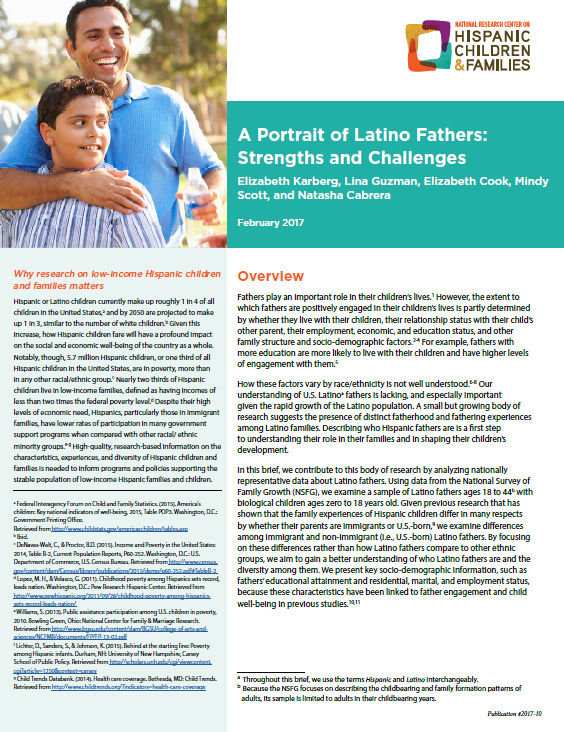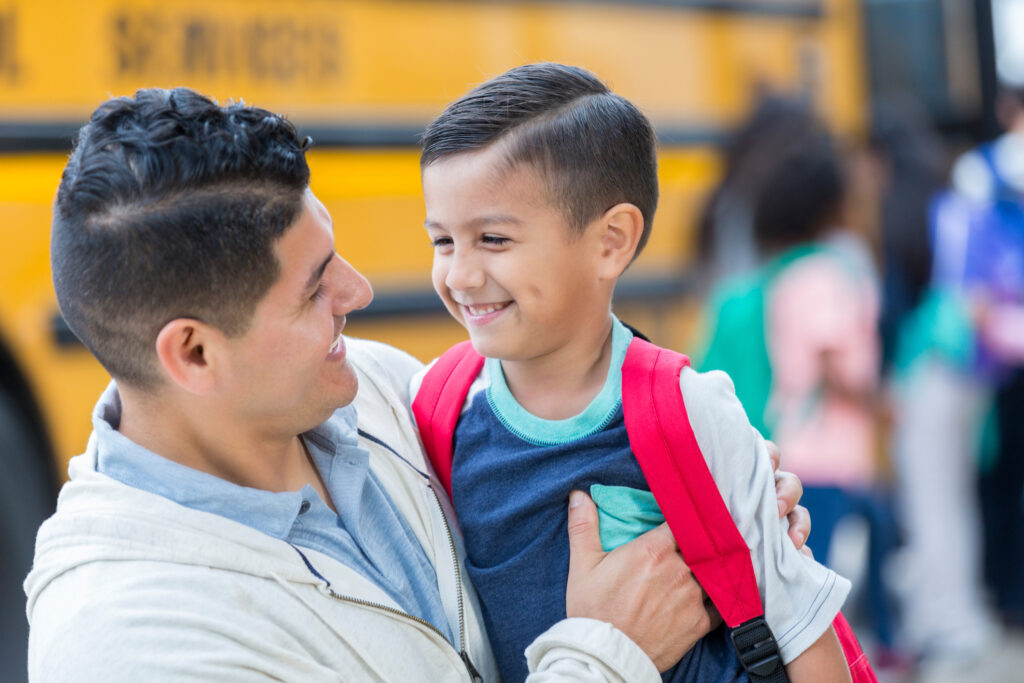Sep 15, 2022
Research Publication
Latinx Families’ Strengths and Resilience Contribute to Their Well-being
Authors:
Below is an overview of this brief. Read the brief in its entirety, here.
Introduction
Latinx families belong to one of the largest, most demographically diverse ethnic groups in the United States; partly as a result of this diversity, they have multiple strengths they can draw on to be resilient in the face of hardship and guard against the negative effects of adversity on their well-being.1,2,3,4,5 Strengths—also referred to in the literature on resilience as assets or promotive factors—include characteristics of individuals (e.g., optimism, bilingualism) and families (e.g., family cohesion, intergenerational households, family support and stability) that increase the likelihood of positive outcomes. When faced with adversities, many Latinx families rely on their strengths to provide a loving and nurturing environment for their children. Consequently, many Latinx children are reared in loving and sensitive homes in which parents invest time and money, increasing their children’s odds of developing the academic and social skills they need to succeed in school and beyond.6
In this brief, we take stock of—and present findings from—the existing research on strengths and resilience within Latinx families. Based on our analysis of the literature, we provide recommendations to researchers for advancing strength-based research on Latino families and to programs and practitioners for building on Latinx families’ strengths in service delivery.
Summary of Key Findings and Recommendations
Key Findings from the literature on Latinx family strengths
These findings draw from 35 studies published from 2000 to 2022—the majority which were quantitative and slightly less than half of which were based on nationally representative datasets. For more information on the studies, see Appendix X. Below, we summarize these findings in terms of strengths of individuals and the strengths held by Latinx parents and families. While we organize these findings thematically, we acknowledge that these strengths cut across levels—that is, they may apply to individual children or parents, to parenting practices, or to families’ structures. While a growing body of research has focused on documenting the strengths of Latino parents and families, few have examined the processes by which strengths may lead to better outcomes among Latinx children and none (to our knowledge) have examined how protective factors function at varying level of risks.
Children’s strong social skills (individual strengths)
- Most Latinx children enter formal schooling with strong social skills, including the ability to develop friendships and be liked and accepted by their peers and teachers.
- Latinx children’s social skills are important for developing resilience because they promote other domains of development.
Biculturalism and bilingualism (individual and parenting strengths)
- Latinx children and families may benefit from their bilingual and bicultural status (i.e., their close identification with both U.S. culture and their heritage culture).
- Being bilingual promotes children’s social and cognitive development.
- Parents’ biculturalism is also promotive of better parenting behaviors, which are, in turn, related to better outcomes in children.
Parenting and parental investments (individual and parenting strengths)
- Many Latinx children experience high-quality parenting, characterized by high levels of warmth and supportiveness.
- Latinx fathers are highly committed to their children and involved in their lives.
- Latinx fathers’ commitment to their children starts early in childhood and is long-term.
- Latinx fathers’ engagement with their children significantly contributes to their cognitive, language, and social development, over and above mothers’ contributions.
Early home learning experiences (family strengths)
- Latinx parents are highly invested in their children’s futures, as evidenced by their frequent engagement in learning experiences—particularly with their preschoolers—which foster the development of early school readiness skills.
- Latinx children’s day-to-day experiences are often characterized by routines and predictability, which support healthy social-emotional development in early childhood.
Family stability, household composition, and familial support (family strengths)
- The majority of young Latinx children with foreign-born parents live in two-parent households that are relatively stable during the early years of life.
- Support from extended family and living in intergenerational households can benefit Latinx children’s cognitive skills and social-emotional functioning.
Family functioning (family strengths)
- High co-parenting relationship quality is another strength of Latinx families: Parents who support each other in their parenting roles are more likely to have fewer conflicts and to show more supportive and responsive parenting, both of which are important for children’s development.
- Parents’ psychological functioning is a promotive factor that can influence young children’s development, through its effects on parenting practices and the quality of the early home environment.
Recommendations for programs, practice, and research
Programs and practice
- Curricula for parenting programs should include the culturally specific ways in which Latinx parents promote child development and should encourage Latinx parents to maintain these practices.7
- Programs should acknowledge Latinx parents’ and families’ strengths (e.g., strong co-parenting relationships) and encourage families to use these strengths as a platform to build further competencies.
- Practitioners should familiarize themselves with and increase their understanding of the cultural beliefs and practices that Latinx parents view as important resources to help them live in the United States.8,9
- Programs should capitalize on Latinx parents’ optimism, or the attribute of thinking positively about the future 10,11,12, because it can reinforce Latinx parents’ positive views of the future to encourage them to continue investing in their children.
- To help build resilience for children and families, programs should invite involvement from fathers and other extended family members who are involved in childrearing and who may be sources of social support for Latinx parents.
- Programs should meet families where they are—in other words, they should recognize that families have diverse backgrounds and inherent strengths—and be flexible and targeted in their programming efforts.
- Programs should build on Latinx parents’ high levels of investment in their children’s futures and engage parents in programs by validating and encouraging these investments.13,14,15,16
Research
- Future research should include more longitudinal studies with large samples of Latinx families to examine within-group variability in individual-level strengths, parenting practices, family functioning, and resilience.
- Studies should more frequently use a strength-based perspective to identify strengths and assets of children, parents, families, and communities so that programs and interventions can reinforce and sustain them.17,18
- Research studies must examine more systemic forms of adversity such as racism and discrimination.
- Research must further extend the study of bilingualism to better understand how it acts as a resource for Latinx children once they enter school settings—and under what conditions it serves as a resource.
- Researchers should also widen the focus of studies to include fathers and extended family members to obtain a more well-rounded view of children’s early home environments.13,14,19
- Researchers should focus on understanding how protective factors operate—that is, the mechanisms through which they impact family functioning—which should offer insight into the types of protective factors necessary to protect families at different levels of risk.
Suggested Citation
Cabrera, N., Alonso, A., Chen, Y., Ghosh, R. (2022). Latinx Families’ Strengths and Resilience Contribute to Their Well-Being. Bethesda, MD: National Research Center on Hispanic Children & Families. https://www.hispanicresearchcenter.org/research-resources/latinx-families-strengths-and-resilience-contribute-to-their-well-being
References
1 Gennetian, L., Rodrigues, C., Hill, H., & Morris, P. (2015). Low and stable income: Comparisons among Hispanic children, from 2004 through the period following the Great Recession. Washington, DC: Child Trends.
2 Karberg, E., Cabrera, N., Fagan, J., Scott, M. E., & Guzman, L. (2017, a). Family stability and instability among low-income Hispanic mothers with young children. Report 2017-12. Bethesda, MD: National Research Center on Hispanic Children & Families. Retrieved from https://www.hispanicresearchcenter.org/wp-content/uploads/2019/08/Family-Stability-and-Instability-V21.pdf
3 Karberg, E., Guzman, L., Cook, E., Scott, M., Cabrera, N. (2017, b). A portrait of Latinx fathers: Strengths and challenges. Report 2017-10. Bethesda, MD: National Research Center on Hispanic Children & Families. Retrieved from https://www.hispanicresearchcenter.org/wp-content/uploads/2019/08/A-Portrait-of-Latinx-Fathers-V21.pdf
4 Masten, A. S. (2014). Invited commentary: Resilience and positive youth development frameworks in developmental science [Editorial]. Journal of Youth and Adolescence, 43(6), 1018–1024. https://doi.org/10.1007/s10964-014-0118-7
5 Turner, K., Guzman, L., Wildsmith, E., & Scott, M. (2015). The complex and varied households of low-income Hispanic children. Report 2015-04. Bethesda, MD: National Research Center on Hispanic Children & Families. Retrieved from https://www.hispanicresearchcenter.org/wp-content/uploads/2019/08/Household-Complexity-Brief-V21.pdf
6 Cabrera, N. J., Shannon, J. D., West, J., & Brooks‐Gunn, J. (2006). Parental interactions with Latino infants: Variation by country of origin and English proficiency. Child Development, 77(5), 1190-1207.
7 Cabrera, N., Hennigar, A., Chen, Y., West, J., Fagan, J., & Wildsmith, E. (2021). Programs can build on the strengths of Latinx families with low incomes to improve outcomes. Report 2021-02. Bethesda, MD: National Research Center on Hispanic Children & Families. Retrieved from https://www.hispanicresearchcenter.org/research-resources/programs-can-build-on-the-strengths-of-latino-families-with-low-incomes-to-improve-outcomes/
8 Aldoney, D., & Cabrera, N. J. (2016). Raising American citizens: Socialization goals of low-income immigrant Latinx mothers and fathers of young children. Journal of Child and Family Studies, 25(12), 3607-3618. https://doi.org/10.1007/s10826-016-0510-x
9 Valdez, C. R., Padilla, B., & Valentine, J. L. (2013). Consequences of Arizona’s immigration policy on social capital among Mexican mothers with unauthorized immigration status. Hispanic Journal of Behavioral Sciences, 35(3), 303-322. https://doi.org/10.1177%2F0739986313488312
10 Castro-Schilo, L., Ferrer, E., Taylor, Z. E., Robins, R. W., Conger, R. D., & Widaman, K. F. (2013). Parents’ optimism, positive parenting, and child peer competence in Mexican-origin families. Parenting: Science and Practice, 13(2), 95–112. https://doi.org/10.1080/15295192.2012.709151
11 He, M., Cabrera, N., Renteria, J., Chen, Y., Alonso, A., McDorman, S. A., Kerlow, M. A., & Reich, S. M. (2021). Family functioning in the time of COVID-19 among economically vulnerable families: Risks and protective factors. Frontiers in Psychology, 12, 730447. https://doi.org/10.3389/fpsyg.2021.730447
12 Cabrera, N., He, M., Chen, Y., & Reich, S. M. (2022). Risks and protective factors of Hispanic families and their young children during the COVID-19 pandemic. Children (Basel), 9(6), 792. https://doi.org/10.3390%2Fchildren9060792
13 Cabrera, N. J., Hofferth, S., & Chae, S. (2011). Patterns and predictors of father-infant engagement: Variation by race and ethnicity. Early Childhood Research Quarterly, 26, 365–375. https://doi.org/10.1016%2Fj.ecresq.2011.01.001
14 Wildsmith, E., Karberg, E., Whitfield, B. (2020). Resident Hispanic fathers report frequent involvement in the lives of their children. Report 2020. Bethesda, MD: National Research Center on Hispanic Children & Families. Retrieved from https://www.hispanicresearchcenter.org/research-resources/resident-hispanic-fathers-report-frequent-involvement-in-the-lives-of-their-children/
15 Serrano-Villar, M., Huang, K. Y., & Calzada, E. J. (2017). Social support, parenting, and social emotional development in young Mexican and Dominican American children. Child Psychiatry & Human Development, 48(4), 597-609. https://doi.org/10.1007/s10578-016-0685-9
16 Mendez, J. L., & Westerberg, D. (2012). Implementation of a culturally adapted treatment to reduce barriers for Latino parents. Cultural Diversity and Ethnic Minority Psychology, 18(4), 363–372. https://doi.org/10.1037/a0029436
17 Masten, A. S. (2018). Resilience theory and research on children and families: Past, present, and promise. Journal of Family Theory & Review, 10(1), 12–31. https://doi.org/10.1111/jftr.12255
18 Gennetian, L. A., Cabrera, N., Crosby, D., Guzman, L., Smith, J. M., & Wildsmith, E. (2021). A strength-based framework for realizing Latino young children’s potential. Policy Insights from the Behavioral and Brain Sciences, 8(2), 152-159. https://doi.org/10.1177/23727322211033618
19 Pilkauskas, N. V. (2014). Living with a grandparent and parent in early childhood: Associations with school readiness and differences by demographic characteristics. Developmental Psychology, 50(12), 2587–2599. https://doi.org/10.1037%2Fa0038179






